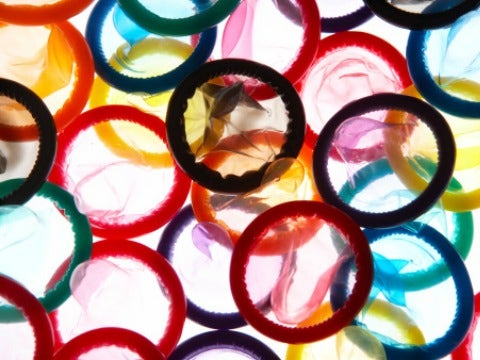The Condom Timeline: A Detailed History Of Wrapping It Up
Turns out, we've been thinking 'no glove? no love!' since 11,000 BC.

Besides the fact that they are one of the best ways to prevent pregnancy, condoms are bringing yet another awesome benefit to our lives. According to a new study from the Beijing Friendship Hospital in China, condoms may actually boost your vaginal health and prevent minor infections from occurring.
That's right: condoms may be good for your reproductive health, which is wonderful, considering how necessary they are for many, many women.
But how much do we really know about condoms and their beneficial wonders throughout history?
Let's take a glance ...
11,000 B.C.: The first evidence of condoms is an arsty one. Caves in France known as Grotte des Combarrelles are said to be the oldest evidence of condoms, with a painting on the wall that scientists say represents them.
1000 B.C.: Some historians argue that condoms made from cloth were used in Ancient Egypt to protect against disease.
1400s A.D.: Glans condoms — ones that only covered the head of the penis — were used in China and Japan. In China, they were made from lamb intestines or oiled silk paper; in Japan, the materials of choice were tortoise shell or animal horn. Hm, tough choice.
1500s: Italian physician and atomist Gabrielle Fallopius writes about the horrors of the then-frequently fatal STD syphilis in De Morbo Gallico. He recommended the use of a protective linen sheath, soaked in chemicals and dried, which would help prevent the acquirement of the disease. Fallopius conducted an experiment using 1,100 participants to determine the early condom's effectiveness; none became infected with syphilis. Condoms to the rescue.
1605: Catholic theologian Leonardus Lessius claimed in De iustitia et iure that condoms are immoral. Side note: strange how we're still facing that argument today?
1600s: Condoms made from animal intestines were first made available to the public. Because of their expensive nature, though, they are frequently reused — something we know to be a big no-no nowadays.
1666: When the birth rate dropped, the English Birth Rate Commission attributed it to "condons" — the first time that word had been published.
1700s: English physician Daniel Turner reportedly stated his belief that condoms encourage men to have unsafe sex with different partners. In fact, around this time, many physicians decried the use of condoms on moral grounds. Nevertheless, the condom market continued expanding. Condoms became more widely available, often made of either "skin" (intestine or bladder treated with sulfur or lye) or linen soaked in chemicals, and are often sold in public places, like pubs or markets.
Early 1800s: More people began publicly advocating for birth control, including condoms (though at the time, they were still not nearly as reliable as they are today when properly utilized).
1839: Charles Goodyear created rubber condoms. More companies follow shortly thereafter.
1889: A bummer for Don Drapers of the 1800s: Ireland made it illegal to advertise condoms, though they could still be made and sold.
Late 1800s: People began using the term "rubber" to mean "condom." Who knew that nickname was so historic?
1912: Julius Fromm, a German chemist, created a new means by which to manufacture condoms wherein he dipped glass molds into raw rubber solution, thus allowing them to have a texture. His line of condoms — Fromm's Act — remains popular in Germany today.
1918: A judge ruled that condoms can be advertised and sold to prevent diseases from spreading. Phew.
1920s: Condom companies stepped up their advertising by making packaging more interesting and names more intriguing. Sales of condoms doubled throughout the world in this decade.
1927-31: Condoms were often distributed to members of the American military and become standard issue for military men.
1950s and 1960s: It's "No balloons? No party!" for 42 percent of Americans, who rely on condoms for birth control and STD prevention at this point in time.
1957: It was a "Wet Hot American Summer," as Durex reveals the first condom with lubrication.
1980s: In the face of the terrifying AIDS epidemic, the contraceptive is marketed as a way to prevent acquiring HIV. Condom use rose as a result.
1997: Durex created the first condom company website. (Let's get digital.)
2013: We now have the ability to buy condoms in all sorts of colors, flavors, textures and materials! The perfect device for nearly everybody's sex life.
More juicy stories from YourTango:

